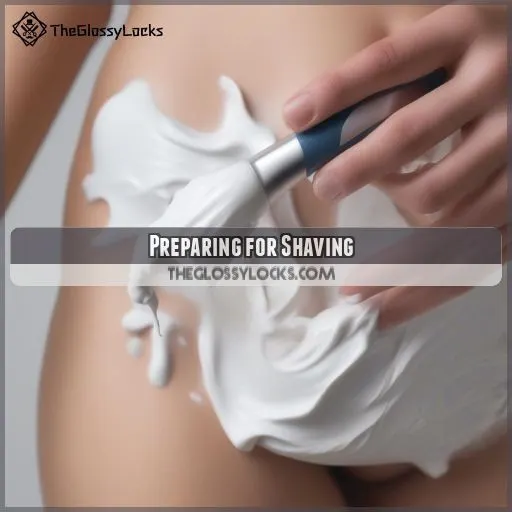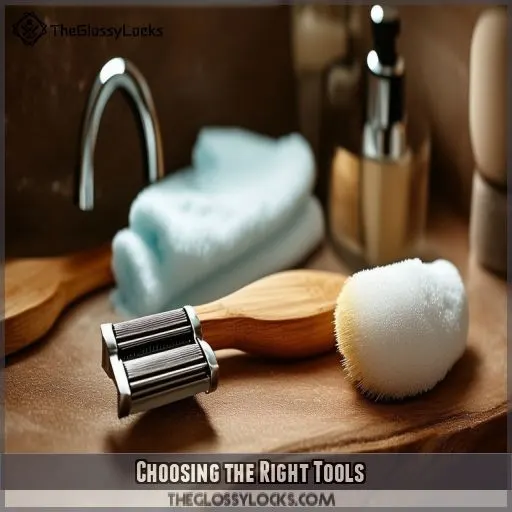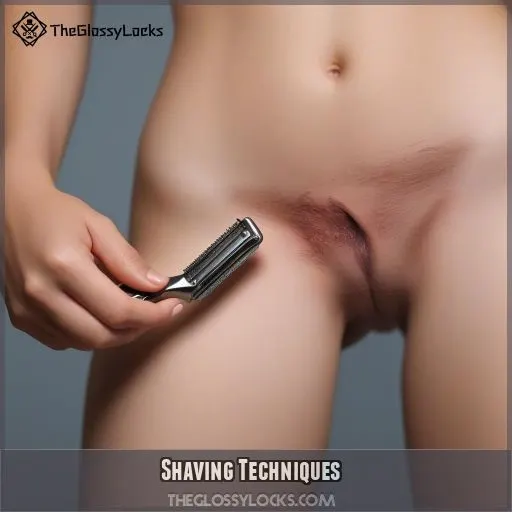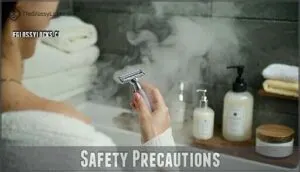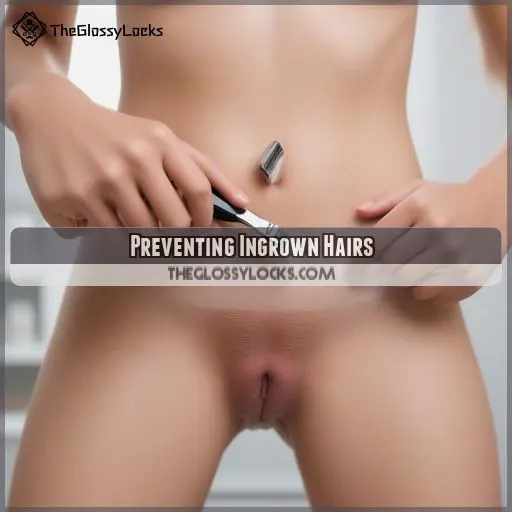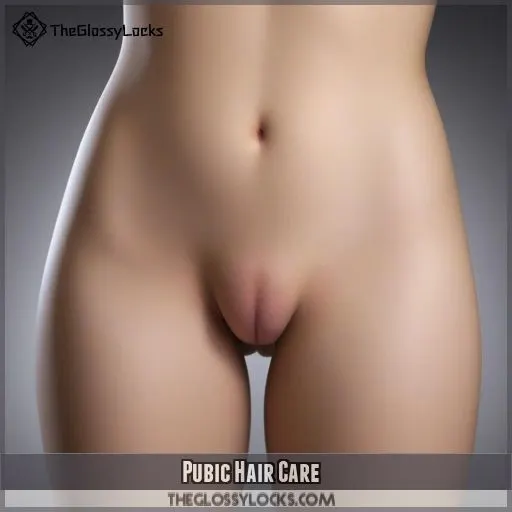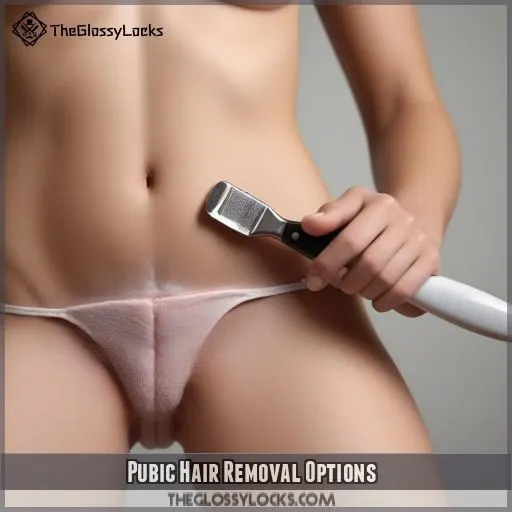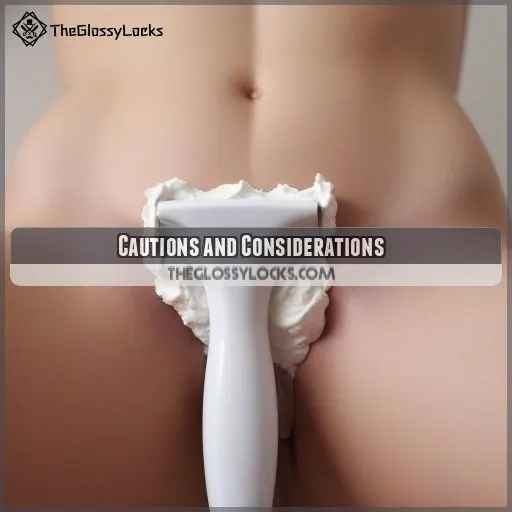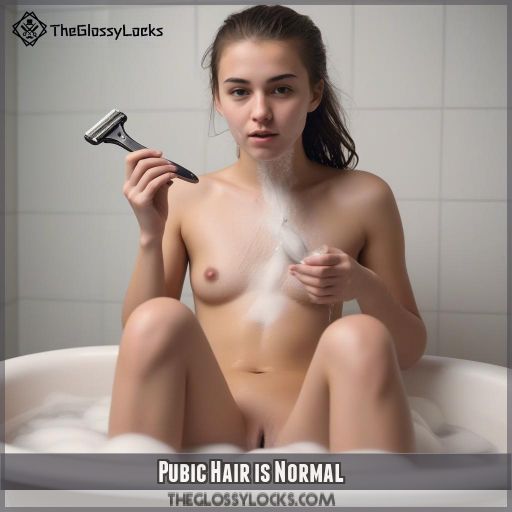This site is supported by our readers. We may earn a commission, at no cost to you, if you purchase through links.
 Ah, the fun of personal grooming! You’ve undertaken the tender task of shaving your pubic area. Though it sounds daunting, with the right approach, you can get smooth results safely.
Ah, the fun of personal grooming! You’ve undertaken the tender task of shaving your pubic area. Though it sounds daunting, with the right approach, you can get smooth results safely.
Here’s a step-by-step guide on how to shave your pubic area, female edition. From preparation to technique, we’ll let you in on everything you need to know
Table Of Contents
- Key Takeaways
- How to Shave Your Pubic Area Female?
- Preparing for Shaving
- Choosing the Right Tools
- Shaving Techniques
- Safety Precautions
- Preventing Ingrown Hairs
- Treating Ingrown Hairs and Nicks
- Pubic Hair Care
- Pubic Hair Removal Options
- Cautions and Considerations
- Pubic Hair is Normal
- Frequently Asked Questions (FAQs)
- Is it good for ladies to shave their private part?
- How to get a smooth pubic area for a female?
- Should I shave pubic hair wet or dry?
- How to remove hair from private parts for a woman?
- How often should I shave my pubic area?
- Can I use hair removal cream on my vulva?
- Is it safe to shave during menstruation?
- How can I reduce razor burn after shaving?
- Should I shave before visiting a gynecologist?
- Conclusion
Key Takeaways
- Prep is key: Trim before you take the plunge, exfoliate like you’re polishing a diamond, and choose your tools wisely. Remember, a dull razor is about as useful as a chocolate teapot!
- Go with the flow: Shave in the direction of hair growth to avoid turning your bits into a pincushion. Light strokes are the name of the game – you’re not mowing the lawn, after all.
- Aftercare isn’t just for tattoos: Moisturize like your life depends on it and treat those ingrown hairs with the tenderness of a first love. Your lady garden will thank you.
- It’s your body, your choice: Whether you’re rocking a full bush or smooth as a dolphin, remember that pubic hair is as natural as rain. Do what makes you feel like a million bucks, and don’t let anyone rain on your parade!
How to Shave Your Pubic Area Female?
To shave your pubic area safely, start by trimming longer hairs and gently exfoliating the skin. Choose a sharp razor with one or two blades, and use shaving cream or a gentle alternative for lubrication.
Always shave in the direction of hair growth using light pressure and short strokes. Rinse the razor frequently and avoid shaving too often to prevent irritation.
After shaving, apply a soothing lotion or serum to minimize ingrown hairs. Keep your razor clean and replace it regularly to avoid bacterial buildup
Preparing for Shaving
Before shaving your pubic area, trim excess hair to a manageable length of a few centimeters using scissors or an electric trimmer. Next, gently exfoliate the skin with a loofah or exfoliating scrub to remove dead skin cells and reduce the risk of ingrown hairs
Trimming Excess Hair
Before you start shaving in the pubic area, it’s very necessary to trim extra hairs so that it makes shaving easy and prevent irritation. Here is how to trim:
- Trim pubic hair to about 1/4 inch long using clean, sharp scissors or an electric trimmer.
- Always trim in the direction of hair growth to prevent ingrown hairs.
- Try not to nick or cut sensitive skin.
It trims your fur, preparing your skin for a smoother shave, with the ability to experiment with hair length. Personal grooming is all about finding comfort in one’s skin. Embrace your body image and choose a style that makes you feel good.
Exfoliating the Skin
Exfoliate your skin; this is the period for that. It’s a necessary process that will help in removing dead skin cells** so that there might not be as much chance of ingrown hairs and skin irritation after you trim off your unwanted body hair.
You can gently scrub with products for sensitive skin, like a loofah or soft-bristled brush. For a smoother approach, use chemical exfoliants that have ingredients containing salicylic acid or glycolic acid. However, be extremely careful not to overdo it! Exfoliate once or twice a week for healthy, non-irritated skin.
Prep work will help a razor glide effortlessly on your skin, reducing nicks and bumps. It will make the shaving cream work better as well and even moisturize better afterward.
Your skin will thank you!
Choosing the Right Tools
When choosing tools for pubic hair removal, select a sharp razor with one or two blades to minimize irritation and cuts. You can use shaving cream for lubrication, but alternatives like soap, water, or shampoo can also work effectively if you prefer
Selecting a Razor
First and foremost, you need to choose the right razor for shaving your pubic area. You want to look for a razor with a new, sharp blade to cause less irritation.
Consider the number of blades: though multi-blade razors are very popular, you may find that one or two blades can be more forgiving if you have sensitive skin. Disposable razors will make things a bit easier, but reusable razors are going to be more cost-effective in the long run.
Be careful about the ergonomics of the handle—you want a comfortable grip when maneuvering over the contours of your mons pubis and labia majora. And be sure to look out for safety features, like moisture strips or pivoting heads.
Believe it or not, a good razor is everything when it comes to getting that smooth, nick-free shave down there
Alternatives to Shaving Cream
If you’re out of shaving cream, don’t worry! You’ve got other options for a smooth shave. Your shower routine can double as prep for hair removal. Here are some alternatives:
- Body wash: Lather up with your favorite cleanser for a slick surface.
- Conditioner: Its moisturizing properties help prevent razor burn.
- Gentle soap: A basic bar soap can do the trick in a pinch
Shaving Techniques
When shaving your pubic area, always move the razor in the direction of hair growth to minimize irritation and ingrown hairs. Use light pressure and short, gentle strokes, rinsing the razor after each pass to keep it clean and effective
Shaving in the Direction of Hair Growth
Now that you’ve chosen the right tools, let’s talk about technique. When shaving your pubic area, always go with the grain. It’s like petting a cat – smooth in one direction, prickly in the other.
Apply your chosen shaving cream or alternative, then use light strokes in the direction your hair grows. This approach helps prevent irritation and those pesky ingrown hairs. Opt for a single-blade razor for precision and safety.
If you’re considering alternatives, laser hair removal might be worth exploring for long-term results
Avoiding Irritation
Now that you’re shaving in the right direction, let’s focus on avoiding irritation. To keep your skin smooth and happy, follow these tips:
- Use light pressure: Pressing too hard can lead to nicks and cuts.
- Take your time: Rushing increases the risk of irritation and ingrown hairs.
- Rinse frequently: Clear your razor of hair and cream to prevent clogging
Safety Precautions
Always use a clean razor, and change the blade after five uses. After shaving, clean your razor well to avoid bacterial buildup, which may help reduce infections.
Avoiding Dull Razors
Now that you have mastered the shaving technique, let’s discuss avoiding using a dull razor. Having a sharp blade will help you avoid razor burn and sensitivity.
Whenever you select your razor, go for a sharp, single- or dual-bladed model designed for sensitive areas, and change your razor after five shaves to ensure optimal performance.
Store your razor properly: It should be kept in a dry place to prevent rust and bacterial growth. If you feel a tug or discomfort when shaving, then it’s time to get a new blade.
Always remember that a dull razor exposes one to nicks and irritation; hence, one shouldn’t be stingy when it comes to quality, especially in one’s intimate areas
Cleaning the Razor
Now, the most important point is that one must clean the razor as sharp after use. Disinfecting your razor aids in the prevention of bacterial growth and reduces the risk of infection; how to clean your razor effectively:
- Rinse the blades with hot running water to wash away hair and debris.
- Using a soft-bristled brush, gently scrub between the blades to loosen any stubborn particles.
- Dip the razor in rubbing alcohol for 30 seconds to kill any remaining bacteria.
Always clean your razor after use to keep it sharp and hygienic. Doing this simple thing won’t only help the razor stay in good condition longer but also prevent any possible skin irritation or infections. Cleanliness, much as in most things, is the key to an efficient and safe shave.
Preventing Ingrown Hairs
To prevent ingrown hairs, exfoliate your pubic area gently between shaving sessions using a soft scrub or exfoliating glove. You can also apply serums specifically designed to prevent ingrown hairs after shaving, which help to soften hair and reduce inflammation in the follicles
Exfoliating Between Shaves
Exfoliating your skin once a week, in between shaving, is the other key element to prevent the problem of ingrown hairs. You’ll help remove dead skin cells that could bundle in your hair follicles and cause issues with new hair growth. Here is a quick guide on how to exfoliate your skin and its benefits:
| Method | Frequency | Tools |
|---|---|---|
| Physical | 1-2x/week | Loofah, scrub |
Use a method that will work well on your skin type. Finding cleansers that exfoliate with the help of gentle ingredients such as salicylic acid or glycolic acid is essential. Take note: overdoing exfoliation can irritate your skin and bring out more problems in turn.
Using Serums
After exfoliating, using serums can be a game-changer in preventing ingrown hairs. These specialized products offer multiple benefits for your delicate skin. Here’s why you should consider adding serums to your routine:
- Targeted treatment: Serums penetrate deeper than lotions, addressing issues at the root.
- Soothing ingredients: Many contain aloe or chamomile to calm irritated skin.
- Exfoliating properties: Some serums have gentle acids that help prevent dead skin buildup.
- Hair softening: Certain formulas can soften hair, making it less likely to become ingrown.
While serums can be pricier than other products, their concentrated formula means a little goes a long way. Always patch test for safety before applying to your entire pubic area
Treating Ingrown Hairs and Nicks
If you notice an ingrown hair, resist the urge to pick or squeeze it. Instead, treat the area with gentle exfoliation and apply a warm compress to soothe the skin and encourage the hair to surface naturally.
For nicks or small cuts, apply gentle pressure to stop any bleeding, clean the area with soap and water, and consider using an antibacterial ointment to prevent infection
Ingrown Hair Treatment
Dealing with ingrown hairs can be painful, but don’t worry – we’ve got your back. To ward off these annoying intruders, pay attention to the direction of hair growth and proper razor choice. If you see one starting to appear, avoid those urges to pick or squeeze. Instead:
| Treatment | Benefits | Usage |
|---|---|---|
| Exfoliation | Removes dead skin | 2-3 times a week |
Warm compress Softening of skin 10 minutes a day
Nick Care
While ingrown hairs can be pesky, nicks are another concern when shaving your pubic area. If you accidentally cut yourself, don’t panic. Apply gentle pressure to stop any bleeding. Clean the area with mild soap and water, then pat it dry.
To prevent infection, apply a thin layer of Aquaphor or another antiseptic ointment. Avoid tight clothing that might irritate the cut.
Keep an eye out for signs of infection like redness, swelling, or unusual discharge. If you notice these symptoms or the cut doesn’t heal, consult a doctor
Pubic Hair Care
Trimming your pubic hair is the safest grooming option, as it shortens the hair without cutting close to the skin. From a medical perspective, there’s no health-related reason to remove pubic hair entirely, as it serves protective functions for your genital area
Trimming and Maintenance
Trimming your pubic hair is just a bit of tender, loving care over your little garden. It just uses vibes that apply to you with your grooming rituals.
First of these things first: know your hair growth—it’s different in everyone. Next, regarding personal hygiene habits, regular trimming will help keep things fresh and at bay.
You’re confused about whether to trim or shave? Trimming’s usually the safer bet to avoid nicks or ingrown hairs.
The length of pubic hair is a matter of preference and, as such, differs from one person to another. You can do experimentation and see what makes you feel comfortable, what would be suitable for your style, and anything else that makes you the boss over your body—trim it the way you want to!
Medical Perspective
From a medical standpoint, your pubic hair isn’t just there for show. It’s your body’s natural defense against friction and infection.
While genital grooming injuries are on the rise, there’s no medical reason to remove all your hair. Dermatological risks like ingrown hairs and infections can be a real pain in the… well, you know where.
Don’t fall for pubic hair myths; it’s not dirty or unhygienic. If you’re dealing with ingrown hair, gentle exfoliation can help, but leave the squeezing to the professionals
Pubic Hair Removal Options
From trimming for a neat look to shaving for a smooth feel, waxing/sugaring for longer-length results, laser hair removal for more permanent reduction, and finally, depilatory creams that efficiently do the job at home, you have many options open to you regarding pubic hair removal, depending on your preferences and how comfortable you feel.
Trimming
Trimming is a safer alternative to shaving your pubic hair. It reduces length without risking skin irritation. Here’s how to trim effectively:
- Choose a clean, sharp trimmer
- Aim for a comfortable length
- Exfoliate beforehand to prevent ingrown hairs
- Remember, body hair is natural
Shaving
Shaving offers a quick, affordable way to remove pubic hair. Choose a sharp razor and shave in the direction of hair growth to minimize irritation. Apply gentle pressure, rinse the blade often, and follow up with after-shave care to prevent ingrown hairs
Waxing or Sugaring
Waxing or sugaring offers longer-lasting results than shaving, but comes with painful side effects. These methods can slow hair regrowth rates but carry skin damage risks. Consider costs vs. benefits and whether to try at-home kits or seek professional services
Laser Hair Removal
Laser hair removal offers a long-lasting alternative to shaving. It zaps hair follicles, reducing growth over time. While pricier and requiring multiple sessions, it can prevent ingrown hairs and shaving irritation. Consider consulting a professional for this high-tech hair removal option
Depilatory Creams
While laser hair removal offers long-term results, depilatory creams provide a quick, painless option. They dissolve hair at the skin’s surface but can cause chemical burns, skin irritation, or allergic reactions. Be cautious and test on a small area first. Hair regrowth occurs faster than with laser treatments
Cautions and Considerations
If you’re planning to undergo surgery in the genital area, avoid shaving, waxing, or using laser hair removal within two weeks of the procedure. There’s also no need to shave before giving birth, as doctors will handle any necessary trimming in the operating room
Avoiding Surgery
When it comes to pubic grooming before surgery, shaving is completely taboo. Consider these safer alternatives:
- Trimming the longer hairs with scissors
- Using electric trimmers with adjustable guards
- Applying hair removal creams on sensitive areas
- Professional grooming, if required
These will guard against skin irritation and razor burns, which increase the risk of infection during an operation. If you must shave, at least do it two weeks before your surgery so that minor nicks and irritations can heal. Just remember that if any hair needs to be removed, it will be done in the operating room by your healthcare team in a sterile environment to be safe.
No Need to Shave Before Birth
You might’ve heard that you need to shave before giving birth, but that’s just not true. There’s no medical reason to remove your pubic hair before labor. In fact, shaving can increase your risk of infection.
Your body knows what it’s doing, and that hair is there for a reason. It helps protect your sensitive areas during the birthing process.
If you’re worried about hygiene, don’t be. The medical staff has seen it all, and they’re focused on your health and your baby’s safe arrival.
Pubic Hair is Normal
Remember that pubic hair is a natural part of your body, serving as protection for your vulva against friction and potential infections. Whether you choose to groom or leave your pubic hair as is, it’s a personal decision that doesn’t require justification or apology to anyone
Natural Protection
Keeping the warnings against pubic hair removal in mind, be aware that your pubic hair is natural and there for some significant reasons. Your body hair exists for a reason, despite societal expectations and some common myths about pubic hair. It provides:
• Protection against rubbing and chafing
• A barrier to dust, dirt, and germs entering your vulva
• Temperature and moisture regulation in the genital area
• A potential role in sexual attraction and pleasure
Your pubic hair is nature’s shield to protect your delicate parts. Pubic hair isn’t just a feature for looks; it’s functional and contributes immensely to your overall vaginal health. Be reminded that there’s no medical basis for removing it entirely.
Personal Choice
Your pubic hair is unique to you, and how you choose to groom it is entirely your decision. Society’s beauty standards and cultural influences often shape our hygiene practices, but remember, there’s no "right" way to manage your pubic hair.
Whether you prefer to let it grow naturally, trim occasionally, or remove it completely, it’s all about what makes you feel comfortable and confident. Don’t let societal expectations dictate your personal choices.
Embrace your body as it is, or modify it as you see fit. What matters most is that you’re making informed decisions about your body that align with your own preferences and values
Frequently Asked Questions (FAQs)
Is it good for ladies to shave their private part?
You’re free to choose what’s best for you. Shaving isn’t medically necessary and can cause irritation or ingrown hairs. If you decide to shave, use proper techniques and clean tools. Consider trimming as a safer alternative
How to get a smooth pubic area for a female?
Sarah wanted a silky-smooth bikini line. For best results, trim first, exfoliate gently, use a sharp razor with shaving cream, and shave in the direction of hair growth. Moisturize after to soothe skin and prevent irritation
Should I shave pubic hair wet or dry?
You should always shave your pubic area wet, not dry. Wet shaving softens hair, opens pores, and reduces irritation. Take a warm shower first, then apply shaving cream for a smoother glide and better protection
How to remove hair from private parts for a woman?
Did you know 83% of genital grooming injuries involve razors? To safely remove pubic hair, trim first, then shave in the shower using a sharp razor and shaving cream. Go with the grain and moisturize after to prevent irritation
How often should I shave my pubic area?
There’s no set rule for how often you should shave. It’s a personal choice based on your comfort and hair growth. Some women shave weekly, others monthly. Listen to your body and avoid over-shaving to prevent irritation
Can I use hair removal cream on my vulva?
Did you know 83% of genital grooming injuries involve razors? Hair removal creams aren’t recommended for the vulva. They can irritate sensitive skin and disrupt pH balance. Stick to gentle trimming or carefully shaving the outer pubic area instead
Is it safe to shave during menstruation?
You can shave during menstruation, but it’s not ideal. Blood can make it slippery and increase the risk of nicks. If you decide to, use extra caution, rinse frequently, and consider waiting until your flow is lighter
How can I reduce razor burn after shaving?
Razor burn got you feeling the heat? Don’t fret! Exfoliate gently before shaving, use a sharp razor with shaving cream, and go with the hair growth. Afterward, apply a soothing aloe vera gel or witch hazel to calm irritated skin
Should I shave before visiting a gynecologist?
You don’t need to shave before a gynecologist visit. They’re professionals who’ve seen it all. Grooming’s a personal choice, not a medical necessity. If you’re more comfortable trimmed, that’s fine, but don’t stress about it
Conclusion
Who knew shaving your pubic area could be so complex? Yet, armed with the right knowledge, you’re now prepared to tackle this delicate task safely.
Follow these tips to minimize irritation and prevent ingrown hairs. Ultimately, your body is yours to groom as you see fit.
Stay safe, stay confident, and rock whatever style makes you feel your best


